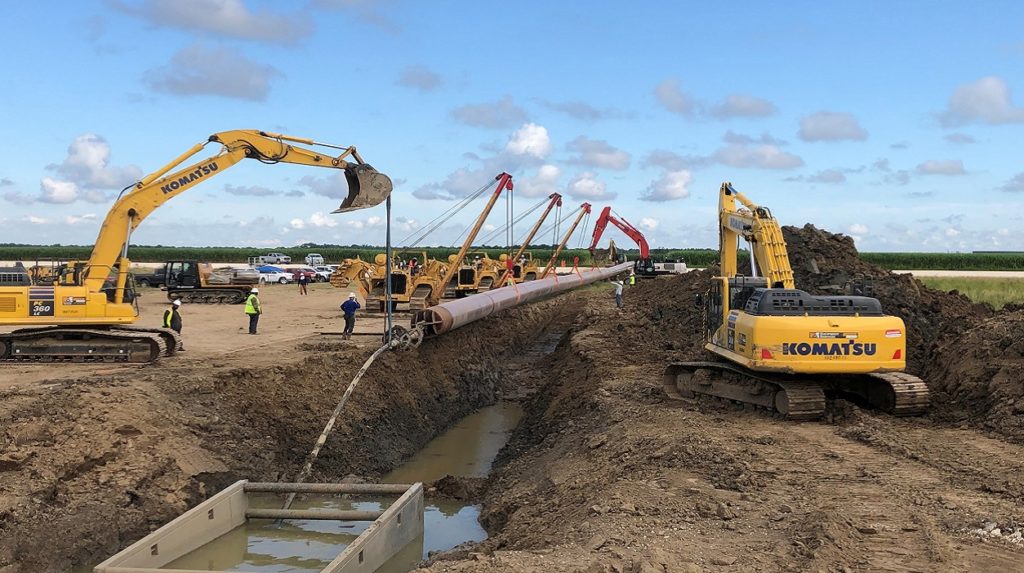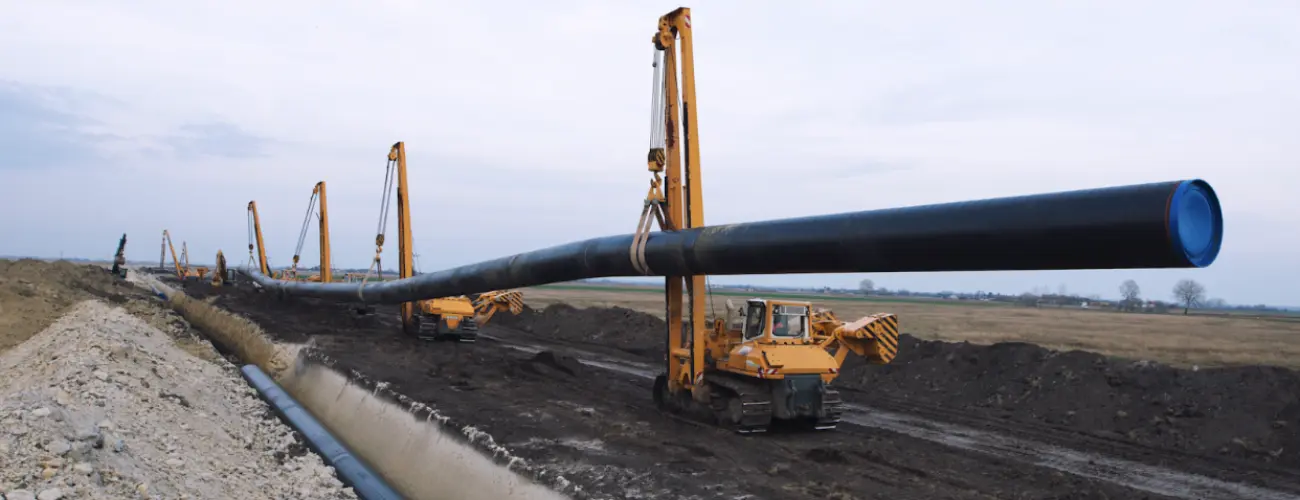Is DIY Worth It? Self-Installing Without Help From Creek Pipe Company
The Relevance of Pipeline Construction: Checking Out the Providers Used in the Industry
Pipeline construction is an important element of modern facilities. It facilitates the transport of crucial sources like oil, gas, and water. The sector encompasses different solutions, including preparation, site preparation, and installment. Each phase needs precision and adherence to security criteria. As communities depend upon these systems for their livelihoods, comprehending the intricacies of pipe construction exposes its value and potential difficulties. What variables affect the success of these projects?
Review of Pipeline Construction Solutions
Pipeline construction solutions encompass a series of specific tasks made to promote the setup of pipelines for carrying numerous materials, consisting of oil, gas, and water. These services usually consist of website prep work, excavation, installment of pipe sections, and backfilling. Proficient labor and advanced equipment are fundamental for ensuring each phase is carried out with accuracy and safety.Safety procedures are vital, as these jobs typically entail dealing with unsafe products and in tough settings. Quality assurance actions identify that the pipes fulfill sector requirements and laws. Furthermore, the solutions might entail trenchless modern technology, which decreases surface area disruption.Environmental considerations play a substantial role in pipe construction, calling for analyses and mitigations to safeguard bordering ecosystems. Overall, pipe construction solutions are vital for establishing the infrastructure necessary for energy and water distribution, sustaining both financial growth and social requirements.
Planning and Layout in Pipeline Projects
Efficient planning and layout are essential elements of successful pipe tasks, making certain that all elements are meticulously resolved prior to construction begins. This phase entails detailed feasibility research studies that assess the technological, financial, and environmental factors affecting the project. Designers and designers team up to develop thorough plans that lay out the pipeline course, materials, and construction approaches, lining up with regulatory needs and market standards.Advanced software program and modeling methods are often utilized to simulate different circumstances, maximizing the style for performance and safety. Ecological influence assessments are performed to mitigate prospective injury to communities and areas, reflecting a commitment to lasting techniques. In addition, stakeholder interaction is essential, promoting interaction and addressing worries from impacted events. Ultimately, effective planning and style established the structure for a pipe task, lessening threats and ensuring a streamlined construction process, eventually contributing to the general success of the procedure.
Website Prep Work and Excavation
Comprehensive site preparation and excavation are necessary steps in the pipe construction procedure. This stage involves a detailed assessment of the land where the pipeline will be installed. Job teams carry out surveys to determine soil kinds, topography, and existing energy lines to assure a safe and efficient excavation. Proper website prep work reduces ecological impact and assists in smoother construction operations.Excavation complies with, where hefty machinery is utilized to eliminate dirt and rock, creating a trench that fulfills the defined deepness and width for the pipeline. This procedure should comply with safety and security laws and ecological standards to stop damage to surrounding ecosystems.Additionally, erosion control steps are executed to stabilize the website throughout and after excavation. Effective site prep work and excavation add considerably to the general success of pipeline tasks, laying a strong structure for the subsequent stages of construction.
Pipeline Installation Methods
Pipeline installation techniques are important for the successful execution of facilities jobs. Two noticeable techniques include trenchless modern technology, which reduces surface disturbance, and the open-cut excavation procedure, known for its uncomplicated technique. Each technique supplies distinctive advantages and considerations depending upon project needs and environmental factors.
Trenchless Modern Technology Methods
While typical techniques of pipe setup typically involve substantial excavation, trenchless technology approaches use a more reliable and eco-friendly alternative. These ingenious techniques, such as horizontal directional drilling and pipeline bursting, minimize surface area disturbance by permitting the installment of pipelines without considerable digging. This not just decreases the ecological influence but additionally significantly reduces down on labor and repair prices. Trenchless methods assist in the installment of pipelines in city locations where traditional excavation would be unwise or destructive to existing infrastructure. Additionally, these methods can fit various dirt kinds and problems, making them versatile services for pipe construction. Eventually, trenchless innovation stands for a considerable development in the pipeline sector, advertising sustainability and functional efficiency.

Open-Cut Excavation Process
Open-cut excavation remains a basic strategy in pipe installment, characterized by the direct excavation of a trench to lay pipelines. This approach entails eliminating soil and various other materials to produce a trench of sufficient depth and size, permitting for the positioning of pipelines at the required quality. Open-cut excavation is usually favored for its cost-effectiveness and simpleness, particularly in areas with secure dirt problems. It can disrupt surface tasks and needs careful preparation to handle traffic and ecological impacts. Precaution should be implemented to shield workers and close-by facilities during the excavation procedure. Overall, while open-cut excavation might not be appropriate for all surfaces, it remains an extensively utilized approach in pipe construction.
Testing and Top Quality Assurance
Examining and top quality guarantee are important elements in pipe construction, guaranteeing that installments satisfy recognized safety criteria and performance demands. Numerous evaluation strategies and approaches are utilized to examine worldly quality and adherence to governing conformity. This systematic technique aids identify prospective concerns before they intensify, guarding the integrity of the pipeline system.

Examination Techniques and Methods
Assessment techniques and methods are important elements in ensuring the integrity and security of pipe construction. Numerous techniques, including aesthetic inspections, ultrasonic testing, and radiographic exams, are employed to find flaws and verify high quality. Aesthetic inspections enable for the recognition of surface area abnormalities, while ultrasonic screening uses audio waves to evaluate wall density and situate flaws internally. Radiographic evaluations entail X-rays or gamma rays to produce pictures of the pipeline's structure, exposing surprise concerns. In addition, pressure testing is conducted to assess the pipeline's stability under operational problems. These approaches jointly contribute to a detailed understanding of the pipe's condition, making it possible for timely upkeep decisions and making sure compliance with industry criteria. direct burial gas line Efficient examination is essential for avoiding failings and advertising lasting functional safety and security.
Safety Criteria Conformity
Making certain conformity with safety standards is paramount in pipeline construction, as it straight affects the project's total quality and dependability. Sticking to recognized regulations and guidelines assurances that construction practices minimize risks connected with pipeline installation and procedure. Creek Pipe roustabout. Strenuous testing methods, including non-destructive testing and stress analyses, are vital in verifying that pipes can stand up to the operational anxieties they will certainly come across. Quality assurance measures are additionally vital, as they establish a structure for consistent tracking and assessment throughout the construction procedure. By prioritizing safety and security requirements conformity, business not just shield workers and the setting but additionally enhance the honesty of the pipeline, ultimately bring about long-term functional success and public count on the framework
Material High Quality Analysis
Product quality assessment plays a substantial role in the general honesty of pipeline construction. This procedure entails rigorous screening and quality assurance actions to guarantee that materials fulfill sector standards and specifications. Numerous examinations, including tensile stamina, deterioration resistance, and weld integrity assessments, are carried out to recognize any possible weaknesses. A detailed evaluation not only ensures the efficiency of the pipe yet also improves safety and security and durability over its life expectancy. Furthermore, carrying out high quality control methods aids minimize risks connected with material failures, which can result in expensive fixings and ecological hazards. By focusing on worldly top quality evaluation, companies can assure compliance with regulatory demands while promoting confidence among stakeholders in the integrity of their pipeline systems.
Maintenance and Fixing Services
Repair and maintenance solutions play a crucial duty in the long life and performance of pipeline systems. These services encompass normal inspections, troubleshooting, and restorative activities to resolve damage, leaks, and other concerns that might occur with time. Knowledgeable professionals use advanced technologies such as ultrasonic screening and wise pigging to monitor pipeline honesty, making certain that any type of potential troubles are determined early.Additionally, upkeep programs commonly include set up safety nets made to improve system reliability and lower the possibility of unexpected failings. Repair solutions may include the substitute of damaged areas, sealing leakages, or employing trenchless modern technology for minimal disruption.
Environmental Conformity and Safety Actions
Pipeline systems not just need recurring upkeep and fixing to operate successfully yet also must stick to rigid ecological compliance and precaution. These guidelines are important for decreasing ecological effect and making sure public safety. Companies in the pipe construction industry execute thorough ecological assessments prior to job initiation, identifying possible threats to wildlife and ecosystems.Furthermore, adherence to safety methods protects employees and surrounding communities. This includes routine training on emergency action and spill prevention techniques.To maintain conformity, industries utilize monitoring modern technologies to discover leaks and other anomalies in real-time. Ecological management strategies are usually created to outline steps for attending to unexpected issues throughout construction.Ultimately, rigorous adherence to environmental conformity and security steps not only meets legal responsibilities however additionally promotes lasting techniques within the industry, advertising an equilibrium between infrastructure advancement and environmental stewardship.
Regularly Asked Questions
What Occupation Opportunities Are Offered in Pipeline Construction?
Career chances in pipe construction incorporate duties such as task supervisors, engineers, welders, and safety inspectors. These settings need varied abilities, offering pathways for growth in an important sector of facilities development and power circulation.

Just How Do Pipeline Projects Influence Citizen Communities?
Pipeline projects significantly impact local areas by influencing financial growth, providing work possibilities, and enhancing framework. Nevertheless, they may additionally increase concerns regarding environmental effects, land usage, and prospective disruptions to neighborhood communication and natural communities.
What Modern technology Is Used in Modern Pipeline Construction?
Modern pipe construction utilizes sophisticated innovations such as GIS for mapping, drones for aerial surveys, and automated welding systems to boost efficiency, security, and accuracy, ultimately assisting in the effective transportation of sources across various terrains. Creek check my site Pipe Company.
Exactly How Are Pipeline Construction Expenses Approximated?
Pipeline construction prices are estimated with thorough assessments of materials, labor, devices, and regulative demands. Variables like surface, job size, and ecological factors to consider also considerably affect the total spending plan and monetary pop over to this site preparation for construction.
What Are the Greatest Difficulties in Pipeline Construction Projects?
The greatest obstacles in pipe construction tasks consist of regulative compliance, environmental problems, logistical issues, securing funding, and taking care of labor scarcities. Each variable can substantially influence timelines and spending plans, making complex the general execution of the project.